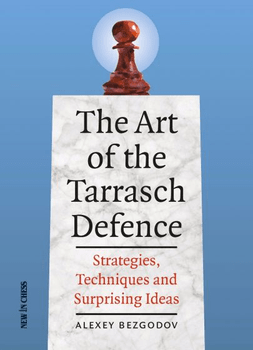| Nivå | C-D |
| Utgivelsesdato | November 2017 |
| Forfatter | |
| Pris | 335 NOK |
The Art of the Tarrasch Defence
Strategies, Techniques and Surprising IdeaEn imponerende bok om Tarrasch dronninggambit som renest oppstår etter 1 d4 d5 2 c4 e6 3 Sc3 c5 4 cxd5 exd5. Stormesteren starter boka med fire varianter som er regnet som dårlige for svart, men som han viser at ikke er det.
I neste kapittel gjennomgår han 12 litt uvanlige, men ikke så sjeldne spillemåter fra hvits side, og hvordan svart skal besvare dem.
Forlagets egen omtale
The Tarrasch Defence is one of the most ambitious ways to play against 1.d4. Black immediately fights for the centre, gets a lot of space and develops his pieces without many problems. Great fighters like Boris Spassky, Paul Keres and Garry Kasparov have played the Tarrasch Defence.
Former Russian Champion Alexey Bezgodov has more than 30 years of experience with the Tarrasch and is one of the world’s greatest experts. The Art of the Tarrasch Defence is a deeply researched journey into the positional structures, the key moments in the fight for the initiative, the players and the variations.
Bezgodov has injected his main line, the neglected Kasparov System, with a lot of surprising ideas and presents new ways to handle White’s offbeat variations. He also shows that quite a few lines for Black with a bad reputation are actually good. He teaches how the giants of chess have exploited the many dynamic possibilities of the Tarrasch Defence, and he includes plenty of practical exercises.
This is a must-have book for fearless players who wish to surprise their opponents and who like to play aggressively with Black -- but only with a reliable opening with a sound positional foundation.
Grandmaster Alexey Bezgodov (1969) was Russian Champion in 1993. He is the author of The Extreme Caro-Kann, The Liberated Bishop’s Defence and The Double Queens Gambit, three highly original chess opening books.
Fra forfatterens forord
For many years, lots of people (both people I know and strangers) have asked me to write a book on the Tarrasch, and now the time has come. The book I am presenting is not quite an opening monograph as such, more a unique journey around this opening.
The deeply-analysed games do not pretend to cover all possible ideas and variations. This would simply be unrealistic – such a book would be too large and cumbersome for the reader. I have tried above all to convey my own experience of studying the opening, to pass on my own doubts, discoveries, my pleasant and not so pleasant experiences. I have done this so as to share with the reader all these riches, although it is not for me ultimately to judge their true worth. Everything that I could possibly do has been done to neutralise those variations which, it seems to me, might present any danger to Black. In the process, I have tried to avoid long and excessively complicated or fanciful variations.
I hope that this book will be read with unhurried pleasure, just as in a restaurant one can enjoy one’s favourite dishes. My 30-year experience in this great opening is before you.
I first met Boris Vasilievich Spassky, one of the ‘giants’ of the Tarrasch who features prominently in The Art of the Tarrasch Defence, in January 2005 at a session of the Spassky School in Satka. He still maintained excellent health and was keenly interested in developments in chess. Spassky was perfectly aware that without his match with Petrosian, the fate of the The Art of the Tarrasch DefenceTarrasch Defence would have been different, and was aware of the latest developments. Against the Kasparov System he considered 12.♕b3, the move Karpov played against Kasparov in their 1984 World Championship match (Game 109 in this book), to be the main danger for Black. In his view, after other options Black’s defence was much easier. He was skeptical of the move 17...♗h5 in the same system, which I had played in my games against Temirbaev and Iskusnyh (in spite of the fact that both games ended in a draw) – he thought this dynamic move was not good enough for equality. But he approved of 17...d4 – see Game 110 in this book. Spassky predicted a very prosperous future for the Tarrasch Defence, especially the 9...cxd4 system.
| Innbundet? | Nei |
| Type | Bok |
| Språk | Engelsk |
| Antall sider | 317 |

